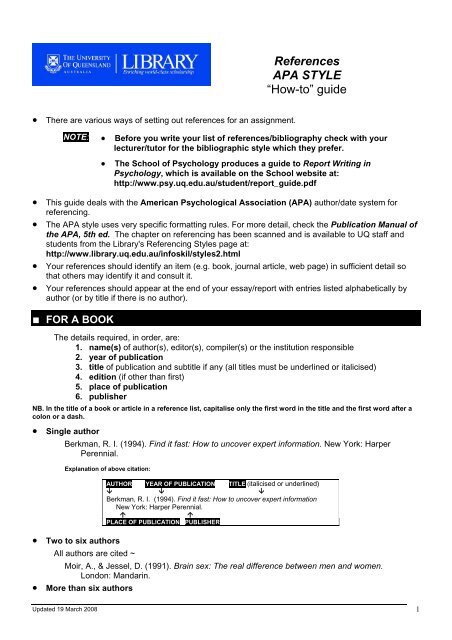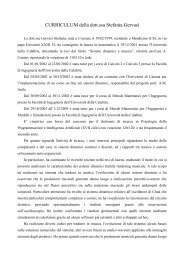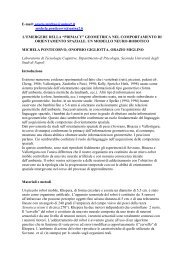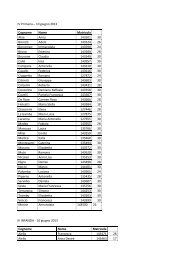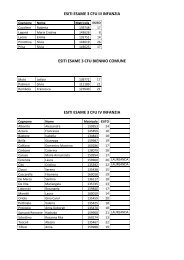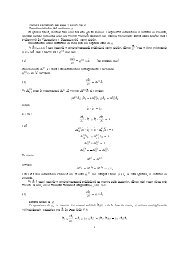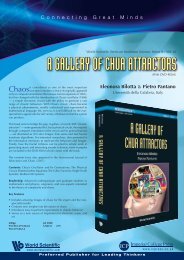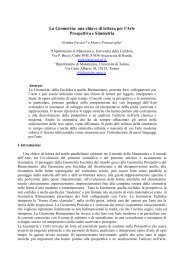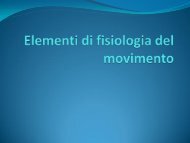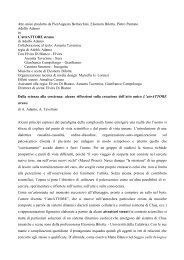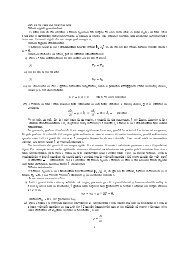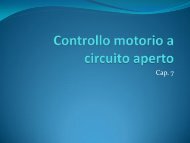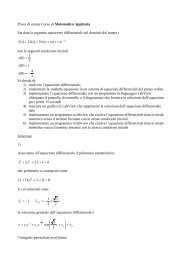HARVARD FORMAT - A STYLE GUIDE TO REFERENCING
HARVARD FORMAT - A STYLE GUIDE TO REFERENCING
HARVARD FORMAT - A STYLE GUIDE TO REFERENCING
Create successful ePaper yourself
Turn your PDF publications into a flip-book with our unique Google optimized e-Paper software.
References<br />
APA <strong>STYLE</strong><br />
“How-to” guide<br />
• There are various ways of setting out references for an assignment.<br />
NOTE: • Before you write your list of references/bibliography check with your<br />
lecturer/tutor for the bibliographic style which they prefer.<br />
• The School of Psychology produces a guide to Report Writing in<br />
Psychology, which is available on the School website at:<br />
http://www.psy.uq.edu.au/student/report_guide.pdf<br />
• This guide deals with the American Psychological Association (APA) author/date system for<br />
referencing.<br />
• The APA style uses very specific formatting rules. For more detail, check the Publication Manual of<br />
the APA, 5th ed. The chapter on referencing has been scanned and is available to UQ staff and<br />
students from the Library's Referencing Styles page at:<br />
http://www.library.uq.edu.au/infoskil/styles2.html<br />
• Your references should identify an item (e.g. book, journal article, web page) in sufficient detail so<br />
that others may identify it and consult it.<br />
• Your references should appear at the end of your essay/report with entries listed alphabetically by<br />
author (or by title if there is no author).<br />
■ FOR A BOOK<br />
The details required, in order, are:<br />
1. name(s) of author(s), editor(s), compiler(s) or the institution responsible<br />
2. year of publication<br />
3. title of publication and subtitle if any (all titles must be underlined or italicised)<br />
4. edition (if other than first)<br />
5. place of publication<br />
6. publisher<br />
NB. In the title of a book or article in a reference list, capitalise only the first word in the title and the first word after a<br />
colon or a dash.<br />
• Single author<br />
Berkman, R. I. (1994). Find it fast: How to uncover expert information. New York: Harper<br />
Perennial.<br />
Explanation of above citation:<br />
AUTHOR YEAR OF PUBLICATION TITLE (italicised or underlined)<br />
<br />
Berkman, R. I. (1994). Find it fast: How to uncover expert information<br />
New York: Harper Perennial.<br />
<br />
<br />
PLACE OF PUBLICATION PUBLISHER<br />
• Two to six authors<br />
All authors are cited ~<br />
Moir, A., & Jessel, D. (1991). Brain sex: The real difference between men and women.<br />
London: Mandarin.<br />
• More than six authors<br />
Updated 19 March 2008<br />
1
When a work has more than six authors cite the surnames & initials of the first six authors then<br />
follow with the abbreviation et al (followed by a full-stop).<br />
• Edited book<br />
Friedman, S. L., & Wachs, T. D. (Eds.). (1999). Measuring environment across the life span:<br />
Emerging methods and concepts. Washington, DC: American Psychological Association.<br />
Everson, S. (Ed.). (1991). Psychology. Cambridge: Cambridge University Press.<br />
• Sponsored by institution, corporation or other organisation<br />
Australian Government Publishing Service (1994). Style manual for authors, editors and<br />
printers (5th ed.). Canberra: Author.<br />
• Series<br />
• Edition<br />
Queensland Tourist and Travel Corporation, Market Research Department (1991). An<br />
examination of the effect of the domestic aviation dispute on Queensland tourism. Brisbane:<br />
Author.<br />
Simons, R. C. (1996). Boo!: Culture, experience and the startle reflex. Series in affective science.<br />
New York: Oxford University Press.<br />
DeHart, G. B., Alan Sroufe, L., & Cooper, R. G. (1995). Child development: Its nature and course<br />
(4th ed.). Boston: McGraw-Hill.<br />
• Article or chapter in an edited book<br />
Baker, F. M., & Lightfoot, O. B. (1993). Psychiatric care of ethnic elders. In A. C. Gaw (Ed.),<br />
Culture, ethnicity, and mental illness (pp. 517-552). Washington, DC: American Psychiatric<br />
Press.<br />
• No author or editor<br />
The CCH Macquarie dictionary of business. (1993). North Ryde, NSW: CCH Australia.<br />
■ FOR A JOURNAL ARTICLE<br />
The details required, in order, are:<br />
1. name(s) of author(s) of the article<br />
2. year of publication<br />
3. title of article<br />
4. title of journal and volume number (underlined or italicised)<br />
5. issue (or part) number for journals without continuous pagination<br />
6. page number(s)<br />
• Journal article (one author)<br />
Mellers, B. A. (2000). Choice and the relative pleasure of consequences.<br />
Psychological Bulletin, 50(2), 49-52.<br />
Explanation of above citation:<br />
AUTHOR YEAR OF PUBLICATION TITLE OF ARTICLE<br />
<br />
Mellers, B. A. (2000). Choice and the relative pleasure of consequences.<br />
Psychological Bulletin, 50 (2), 49-52.<br />
<br />
TITLE OF JOURNAL and VOLUME NO<br />
(italicised or underlined)<br />
ISSUE NO PAGE NOS<br />
(Issue included in journals without continuous<br />
pagination)<br />
Updated 19 March 2008 2
• Conference paper<br />
Bohrer, S., Zielke, T., & Freiburg, V. (1995). Integrated obstacle detection framework<br />
for intelligent cruise control on motorways. Paper presented at IEEE Intelligent Vehicles<br />
Symposium. Detroit, MI: Piscataway.<br />
• Newspaper article (with author)<br />
Cook, D. (2002, January 28). All in the mind. The Age, p. 8.<br />
• Newspaper article (no author)<br />
Meeting the needs of counsellors. (2001, May 5). The Courier Mail, p. 22.<br />
■ FOR MULTIMEDIA MATERIAL<br />
The details required are the same as for a book, with the Format of the item after the title.<br />
Get the facts (and get them organised). (1990). [Videotape]. Williamstown, Vic: Appleseed<br />
Productions.<br />
■ FOR INTERNET and OTHER ELECTRONIC SOURCES<br />
• Cite the same information as for a printed item, and add as much electronic retrieval<br />
information as needed for others to locate the source.<br />
• Retrieval date is not necessary for content that is not likely to be changed or updated.<br />
• A database name is only required for hard-to-find items.<br />
• Give the URL of the home page or menu page for items which can only be accessed by<br />
subscription, for dictionaries and encyclopedias, and for material presented in frames.<br />
Example ~<br />
Smye, V., & Mussell, B. (2001). Aboriginal mental health: What works best, a discussion paper.<br />
Retrieved from Mental Health Evaluation & Community Consultation Unit:<br />
http://www.mheccu.ubc.ca/documents/publications/discussion-paper.pdf<br />
If you are citing a journal article which you accessed electronically, include the Digital Object<br />
Identifier (DOI) if the article has a DOI. If there is no DOI, give the URL of the journal home page<br />
for those journals which can only be accessed by subscription (i.e. by using your UQ username<br />
and password). If the article is freely available on the web, give the full URL of the article.<br />
Examples ~<br />
Article with DOI<br />
Degenhardt, L., Bohnert, K. M., & Anthony, J. C. (2008). Assessment of cocaine and other drug<br />
dependence in the general population: 'Gated' versus 'ungated' approaches. Drug and<br />
Alcohol Dependence, 93(3), 227-232. doi:10.1016/j.drugalcdep.2007.09.024<br />
Article with no DOI – Available by subscription only<br />
Kenardy, J., & Piercy, J. A. (2006). Effect of information provision on trauma symptoms following<br />
therapeutic writing. Australian Psychologist, 41(3), 205-212. Retrieved from<br />
http://www.psychology.org.au/Journal.aspx?ID=1202<br />
Updated 19 March 2008 3
Article with no DOI – Freely available online<br />
Cleary, J. M., & Crafti, N. (2007). Basic need satisfaction, emotional eating, and dietary restraint<br />
as risk factors for recurrent overeating in a community sample. Electronic Journal of Applied<br />
Psychology, 3(2), 27-39. Retrieved from http://ojs.lib.swin.edu.au/index.php/ejap/article<br />
/view/90/116<br />
■ REFERENCES IN THE TEXT OF YOUR ESSAY<br />
• In the APA style, a textual citation generally requires the surname of the author(s), the year of<br />
publication and specific page number(s) when quoting directly from the source.<br />
• Alternatively, the author’s surname may be integrated into the text, followed by the year of publication<br />
in parentheses.<br />
Examples<br />
1. “It is futile to maintain that the sexes are interchangeable” (Moir & Jessel, 1991, p. 94).<br />
2. Moir and Jessel (1991) suggested that “it is futile to maintain that the sexes are<br />
interchangeable” (p. 94).<br />
■ SAMPLE LIST OF REFERENCES<br />
The following are examples of entries in a list of references or bibliography.<br />
NOTE:<br />
• A list of references contains details only of those works cited in an<br />
assignment.<br />
• If no author is given, the title of the work is used as the first<br />
element of a citation.<br />
• If no year of publication is given, use n.d. (standing for "no date")<br />
instead of the year.<br />
Australian Government Publishing Service. (1994). Style manual for authors, editors and<br />
printers (5th ed.). Canberra: Author.<br />
Berkman, R. I. (1994). Find it fast: How to uncover expert information. New York: Harper<br />
Perennial.<br />
Bernstein, D. (1995). Transportation planning. In W. F. Chen (Ed.), The Civil Engineering<br />
Handbook. (pp.159-196). Boca Raton: CRC Press.<br />
Bohrer, S., Zielke, T., & Freiburg, V. (1995). Integrated obstacle detection framework<br />
for intelligent cruise control on motorways. Paper presented at IEEE Intelligent Vehicles<br />
Symposium. Detroit, MI: Piscataway.<br />
Cook, D. (2002, January 28). All in the mind. The Age, p. 8.<br />
DeHart, G. B., Alan Sroufe, L., Cooper, R. G. (1995). Child development: Its nature and course<br />
(4th ed.). Boston: McGraw-Hill.<br />
Doherty, N. (2000). Managing careers into the 21st century. Journal of Occupational and<br />
Organizational Psychology, 73, 387-388.<br />
Griffith, T. L. (1993). Monitoring and performance: A comparison of computer & supervisor<br />
monitoring. Journal of Applied Social Psychology, 23(7), 549-572.<br />
Updated 19 March 2008 4
Jacobson, J. W., Mulick, J. A., & Schwartz, A. A. (1995). A history of facilitated communication:<br />
Science, pseudoscience, and antiscience. American Psychologist, 50(9), 750-765.<br />
McTaggart, D., Findlay, C. & Parkin, M. (1995). Economics (2nd ed.). Sydney: Addison-<br />
Wesley.<br />
Meeting the needs of counsellors. (2001, May 5). The Courier Mail, p. 22.<br />
Mellers, B. A. (2000). Choice and the relative pleasure of consequences.<br />
Psychological Bulletin, 50(2), 49-52.<br />
Moir, A., & Jessel, D. (1991). Brain sex: The real difference between men and<br />
women. London: Mandarin.<br />
Robinson, W. F., & Huxtable, C. R. R. (Eds.). (1988). Clinicopathologic principles for<br />
veterinary medicine. Cambridge: Cambridge University Press.<br />
If you require further information, refer to the complete text of the APA manuals, which can be accessed<br />
online via the Library's Referencing Styles page at:<br />
http://www.library.uq.edu.au/infoskil/styles2.html<br />
Ask at the Information Desk in any Branch Library<br />
Updated 19 March 2008<br />
5


